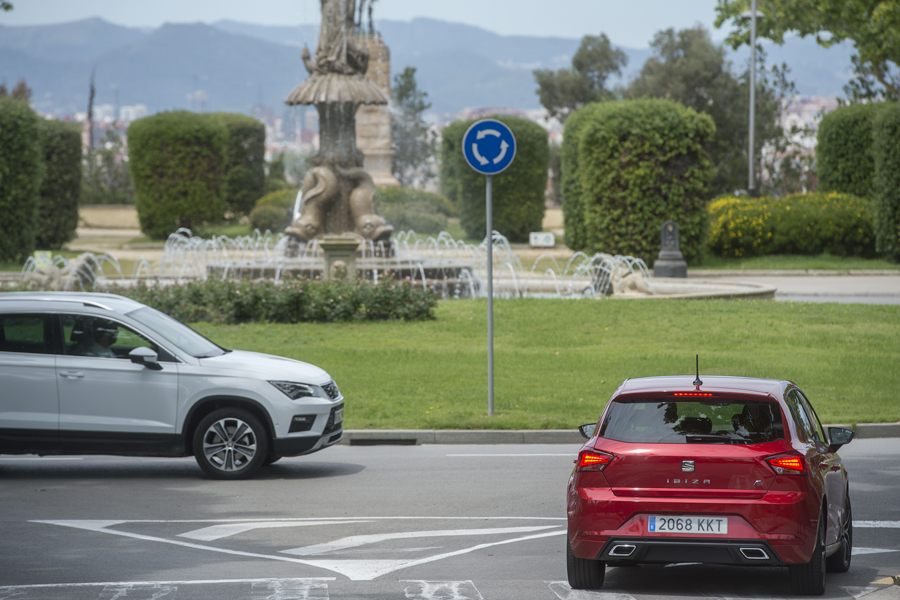Guidelines for navigating a roundabout

Traffic rules
- Several studies show that two out of three drivers do not know how to drive in a roundabout
- The entries to a roundabout are where more than half of the accidents take place
- Giving way to those inside a roundabout and choosing the proper lane according to where you want to exit are the main rules to observe
Martorell, 29/01/2021. Roads and motorways of all descriptions around the world are full of roundabouts. But they all have one thing in common: the hesitation drivers have when driving in and around them. In fact, according to a study carried out by Axa in Spain, two out of every three users do not know how to drive properly in a roundabout. Who has the right of way? Which lane should I be in? When must I use the turn signals? Below is a guide for successfully driving in a roundabout.
Slow speed: Approaching a roundabout is one of the most delicate moments. According to Axa, 54% of accidents in a roundabout occur when entering it. The first recommendation when arriving at a roundabout is to slow down. In the case of travelling to countries such as the United Kingdom, Ireland or Australia, remember that the entry and exit are on the left.
Giving way: The second golden rule is to give way to those inside the roundabout. Any time a driver is in doubt as to whether they have enough time to enter safely, experts recommend waiting until the manoeuvre can be carried out without the risk of accident.
Choosing the proper lane: The moment has come to drive into the roundabout. In general, it is advisable to drive on the outside to cross fewer lanes and make manoeuvres safer. On the other hand, if you are going to make a U-turn or take one of the furthest exits, you should use the inside lanes.
Assistants such as Lane Assist can help you stay in your lane. “With a front camera that recognises lane markings, Lane Assist warns you if you are about to swerve out of your lane” points out Marc Seguer, head of Safety Assistants at SEAT.
One more time around: When you want to exit a roundabout, you have to signal and move into the outside lane. The car in the outside lane always has the right of way. If there is another vehicle already in the lane when you want to move, the best advice is to go around the roundabout again until it is clear and you can exit safely.
Always use your turn signal: This is one of the most confusing aspects of a roundabout. You only need to turn it on when you exit and change lanes, not when entering or to indicate that you wish to continue. New technologies help to improve the visibility of turn signals. For example, the SEAT Tarraco features a dynamic indicator: several light segments that light up progressively from the centre outwards. “A sweeping movement that allows other drivers to perceive the direction of the vehicle more clearly, which is a significant contribution to road safety” says Magnolia Paredes, the head of electronic development, lighting and testing at SEAT.
A group of cyclists is a single vehicle: Special attention must be paid to cyclists, as they are more vulnerable. But in addition, when they ride in a group, as soon as the first one enters or leaves a roundabout, the rest have the right of way even over the vehicles already inside a roundabout. Many drivers are unaware of this rule, but the whole group should be seen as one vehicle, and therefore you must wait until the last one passes.
Above all, keep calm: Roundabouts often test a driver’s patience, but it is forbidden to blow your horn to show anger or to reproach other drivers’ manoeuvres. It can only be used to warn of a possible accident.
The most remarkable roundabouts
France has the most roundabouts of any country, with one every 21 kilometres. But all over the world there are many different roundabouts.
The oldest: The Arc de Triomphe roundabout in Paris (France) is the oldest in the world. 12 avenues converge at this intersection. It is also known for its high number of accidents. In fact, novice drivers are not allowed to drive through it.
The most complex: The Magic Roundabout in Swindon (UK) is considered to be the most complex ring junction in the world. It has a total of seven roundabouts arranged in a circle and the traffic is different in each one of them.
The smartest: The advantage of roundabouts is that they reduce traffic by keeping vehicles moving, but if the road is occupied by pedestrians it loses its efficiency. That is why in Lujiazui, in Shanghai (China), a raised pedestrian ring was built that connects with the underground station, the nearby skyscrapers and the most visited historical buildings.
The largest: South of Kuala Lumpur in Malaysia is the world’s largest roundabout, Putrajaya. It has an area of 4,500 square meters and the land in the middle was put to use by building a 5-star hotel, the second residence of the country’s Prime Minister and the Petra Perdana Gardens.





